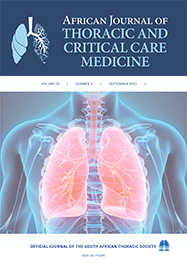Original research

Prognostic value of the Quick Sepsis-related Organ Failure Assessment (qSOFA) score among critically ill medical and surgical patients with suspected infection in a resourcelimited setting
Abstract
Background. The Quick Sequential Organ Failure Assessment (qSOFA) score is a simple bedside tool validated outside of the intensive care unit (ICU) to identify patients with suspected infection who are at risk for poor outcomes.
Objectives. To assess qSOFA at the time of ICU referral as a mortality prognosticator in adult medical v. surgical patients with suspected infection admitted to an ICU in a resource-limited regional hospital in South Africa (SA).
Methods. We conducted a retrospective cohort study on adult medical or surgical patients that were admitted to an ICU in a resource-limited hospital in SA. We performed univariate and multivariable logistic regression and compared nested models using likelihood ratio test, and we calculated the area under the receiver operating characteristic curve (AUROC).
Results. We recruited a total of 1 162 (medical n=283 and surgical n=875) participants in the study who were admitted to the ICU with suspected infection. qSOFA at the time of ICU referral was highly associated with but poorly discriminant of in-ICU mortality among medical (odds ratio (OR) 2.60, 95% confidence interval (CI) 1.19 - 5.71; p=0.02; AUROC 0.60; 95% CI 0.53 - 0.67; p=0.02) and surgical (OR 2.74; 95% CI 1.73-4.36; p<0.001; AUROC 0.60; 95% CI 0.55 - 0.65; p=0.04) patients. qSOFA model performance was similar between medical and surgical subgroups (p≥0.26). Addition of qSOFA to a baseline risk factor model including age, sex, and HIV status improved the model discrimination in both subgroups (medical AUROC 0.64; 95% CI 0.56 - 0.71; p=0.049; surgical AUROC 0.69; 95% CI 0.64 - 0.74; p<0.0001).
Conclusion. qSOFA was highly associated with, but poorly discriminant for, poor outcomes among medical and surgical patients with suspected infection admitted to the ICU in a resource-limited setting. These findings suggest that qSOFA may be useful as a tool to identify patients at increased risk of mortality in these populations and in this context.
Authors' affiliations
L A Bishop, Department of Internal Medicine, School of Clinical Medicine, University of KwaZulu-Natal, Pietermaritzburg, South Africa
D P K Wilson, Department of Internal Medicine, School of Clinical Medicine, University of KwaZulu-Natal, Pietermaritzburg, South Africa
R D Wise, 2 Discipline of Anaesthesiology and Critical Care, School of Clinical Medicine, University of KwaZulu-Natal, Durban, South Africa; Adult Intensive Care Unit, John Radcliffe Hospital, Oxford University Hospitals NHS Foundation Trust, Oxford, United Kingdom
S M Savarimuthu, Division of Pulmonary, Critical Care and Sleep Medicine, Yale School of Medicine, New Haven, Connecticut, USA
G L Anesi, Division of Pulmonary, Allergy, and Critical Care, University of Pennsylvania Perelman School of Medicine, Philadelphia, USA
Full Text:
Cite this article
Article History
Date published: 2022-02-01
Article Views
Full text views: 208
Refbacks
- There are currently no refbacks.
African Journal of Thoracic and Critical Care Medicine| Online ISSN: 2617-0205
This journal is protected by a Creative Commons Attribution - NonCommercial Works License (CC BY-NC 4.0) | Read our privacy policy.
Our Journals: South African Medical Journal | African Journal of Health Professions Education | South African Journal of Bioethics and Law | South African Journal of Child Health | Southern African Journal of Critical Care | African Journal of Thoracic and Critical Care Medicine| South African Journal of Obstetrics and Gynaecology |



.jpg)